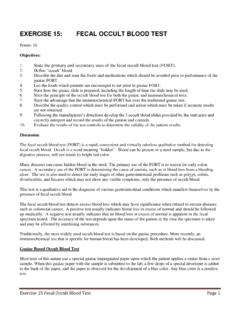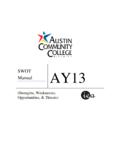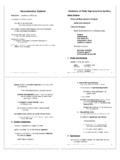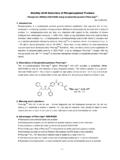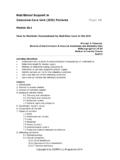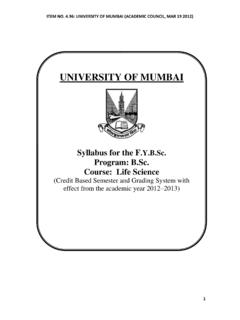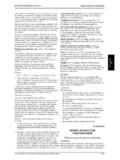Transcription of Unit: Proteins-Total Protein - Austin Community …
1 MLAB 2401 - Clinical Chemistry Lab Manual C H 137 of total Protein , Albumin and GlobulinsObjectivesUpon completion of this exercise, the student will be able the ratio of albumin and globulin in total the total Protein by Biuret albumin by the BCG globulin the clinical significance of abnormal Protein is a complex mixture of cells suspended in a fluid medium, plasma. 92-93% of this fluidmedium is water and the remaining 8% is dissolved proteins, minerals, glucose, etc. By far, thelargest amount of the total solutes are the plasma proteins, collectively referred to as TOTALPROTEIN. In serum, one of the plasma proteins, FIBRINOGEN, is missing, but it only constitutes3-6% of the total Protein in plasma. To standardize normal values, measurement of total proteinhas been confined primarily to serum the basis of their solubility properties, the serum proteins can be divided into two majorfractions, ALBUMIN and GLOBULINS.
2 The globulins can be further subfractionated into four12major fractions: " globulin, " globulins, $ globulins, and * globulins. Serum proteins serve anumber of different functions. They constitute a portion of the amino acid pool of the body. Theycan be de-aminated to give ketoacids which can provide caloric energy, or be transformed intocarbohydrates and lipids. Some serum proteins are also transport agents, carrying many vitalmetabolites, metal ions, carbohydrates and lipids. Enzymes, antibodies, and certain hormonesare also proteins. Serum proteins are important in maintaining the osmotic pressure and the pHof the blood. Liver produced fibrinogen and prothrombin proteins play a major role in constitutes gm/dL of the Protein in plasma.
3 There is a small diurnal variation of total plasma proteinof about Protein concentration:dehydration all fractions affected equallymultiple myeloma (and related diseases) one fraction greatly increased, usually gammaDecreased Protein concentration:kidney damageextensive bleedingsevere burnsinadequate intakedeficient absorptionAlbumin makes up about 60% of the total plasma proteins. It has a relatively small size (MW =69,000). It is synthesized exclusively in the liver and acts as a carrier for many ions and water-soluble substances (calcium, bilirubin, fatty acids). It also acts to maintain osmotic : Proteins (continued)H 138 C MLAB - Clinical Chemistry 2401 Lab ManualAlbumin is increased in dehydration. It is decreased in renal disease (nephrotic syndrome withprotein lost in urine), liver insufficiency with decreased albumin synthesis, severe malnutrition,acute and chronic inflammation, malignancy, pregnancy, and globulin fraction of Protein can be obtained from electrophoresis or calculated by subtractingthe albumin from the total Protein .
4 The quantity of the globulin fraction is required to calculate theA/G of Method In this determination, the total nitrogen ( Protein nitrogen plus non- Protein nitrogen) is determined in the serum by Nessler's reaction after the proteins areconverted to ammonium sulfate. Calculations are needed to compensate for non- Protein nitrogen measured and to convert nitrogen measurement to proteinconcentration. Each gm of nitrogen represents grams of Protein .) In this reaction, a deep blue colored compound is formed when aphenol reagent is added to alkalinized Protein The refractive index of an aqueous solution increases directly withan increase in solute concentration. Even though changes in concentration of differentsubstances may affect the refractive index unequally, the concentrations of electrolytesand small organic molecules in serum usually do not vary greatly; hence, a change inrefractive index is indicative of a change in Protein concentration.
5 A rapid and directway of measuring the serum total proteins requiring only one drop of serum. Valuesobtained by refractive index correlate well with those found by the Biuret method, butdiscrepancies should be expected when abnormal serum proteins (paraproteins) arepresent or in specimens that are lipemic, icteric, or Method All soluble proteins, on addition of a copper salt in alkaline solution(NaOH), give purple colored complex which is generally known as biuret. This methoduses a standardized alkaline copper tartrate solution. The reaction occurs in thepeptide bonds of tripeptides or Method The globulin in serum is precipitated by the addition of 23% sodiumsulfate (salting out). Ethyl-ether is added to help separate the precipitated globulin bycentrifugation.
6 The chemical determination of albumin is based on the formation of apurple colored complex (biuret) between alkaline copper sulfate and the Dye-Binding In recent years, the ability of albumin to combine with dyes hasbeen utilized. Methyl orange, bromcresol green (BCG) and 2,4-hydroxyazobenzenebenzoic acid (HABA) are the colored dyes most commonly used. Under idealconditions, the dye binds to serum albumin, but not to other proteins in : Proteins (continued)MLAB 2401 - Clinical Chemistry Lab Manual C H - Globulin is calculated by subtracting the measured albumin from the measuredtotal = total Protein - Color & solution ( ) ReagentReferencesKaplan, Alex. Clinical Technical Bulletins, #540, #630 Bishop.
7 Clinical Chemistry, pages Protein - Sigma 541-2 ReagentsBiuret Reagent - A standardized alkaline copper tartrate solution (copper sulfate and sodiumhydroxide)SpecimenFresh test tubes for blank, standard(s), controll(s) and ml sample to appropriate ml Biuret reagent to each to stand 10 - 15 minutes at room absorbance at 540 nm using blank to zero the a series of standards are analyzed, a standard curve can be used to determine theconcentration of the unknowns. 2. But if only one standard is analyzed in the test run, the total Protein is calculated as follows: unit : Proteins (continued)H 140 C MLAB - Clinical Chemistry 2401 Lab ManualExpected ValuesAdult normal = - g/dLAlbumin Reagents Albumin reagent bromcresol greenSpecimen Fresh 1:5 dilution of each standard, control, and sample using NaCl (normal saline) test tubes for blank standard, control and each tube, add ml albumin color ml of diluted sample to appropriate tubes.
8 To blank tube, add ml well and allow to stand at room temperature for 10 absorbance of each test at 630 nm using blank to zero the ValuesNormal Range = - g/dLUNIT: Proteins (continued)MLAB 2401 - Clinical Chemistry Lab Manual C H 141 Name Date Protein ProteinWavelength_____Linearity_____Spec trophotometer Used _____Identification AbsorbanceConcentration(units)Refractome terReadingStandard _____Standard _____Standard _____Control 1 _____Control 2 _____Calculation formula(s) and examplesTotal Protein Quality ControlYour ResultsControls range of expected control? Yes / NoLevel 1 ID_____Level 2ID_____Accepting Patient Results?ReasonUNIT: Proteins (continued)H 142 C MLAB - Clinical Chemistry 2401 Lab Used _____Identification AbsorbanceConcentration (units)Standard _____Standard _____Standard _____Control 1 _____Control 2 _____Calculation formula(s) and examplesAlbumin Quality ControlYour ResultsControls range of expected control?
9 Yes / NoLevel 1 ID_____Level 2ID_____Accepting Patient Results? IdentificationConcentration (units)Control 1 _____Control 2 _____Calculation formula(s) and examplesUNIT: Proteins (continued)MLAB 2401 - Clinical Chemistry Lab Manual C H 143 Name Date Study QuestionsInstructions: Based on information presented in lecture and lab notes, answer the followingquestions. Legibly write your answers in the space provided. Unless otherwise indicated, eachquestion is worth one proteins are synthesized in the _____. are the two major fractions of serum proteins? why serum rather than plasma is the preferred specimen for total blood Protein group is the smallest in molecular weight?
10 Biuret method measures the presence in the Protein molecule ingredients of all biuret reagents potassium tartrate and tungstate and sulfuric sulfate and sulfuric sulfate and sodium oxide and sodium is the physiological role of albumin? globulin concentration of a patient with a total Protein of gm/dL and an albumin gm/dL is the Kjeldahl Method, what is actually being measured? unit : Proteins (continued)H 144 C MLAB - Clinical Chemistry 2401 Lab three (3) dyes that have been commonly used in the quantitation of absorbance of the patient's sample in an albumin procedure is The gm/dLstandard gave an absorbance of What should be reported to the doctor? explain why normal saline rather than distilled water is used for Protein or albumindilutions.




